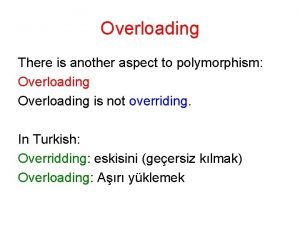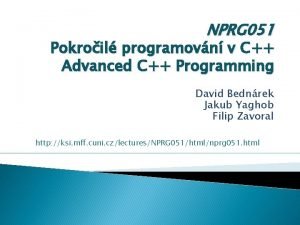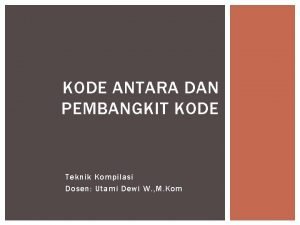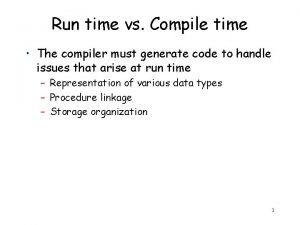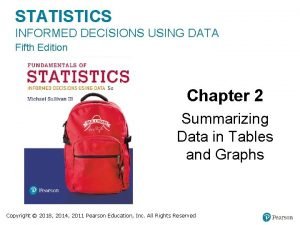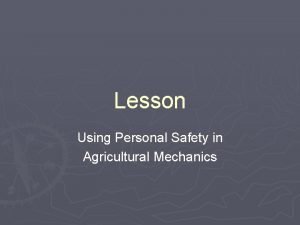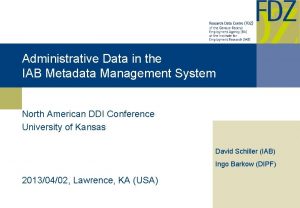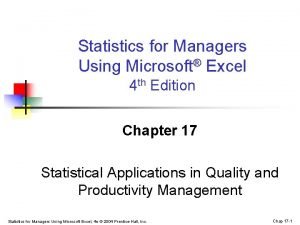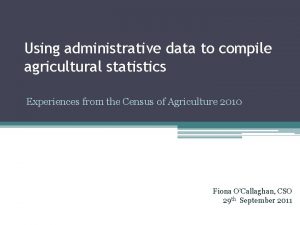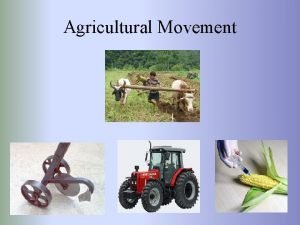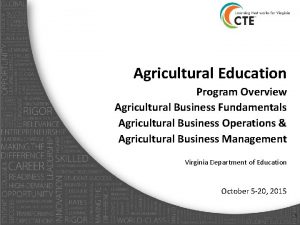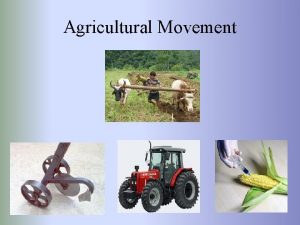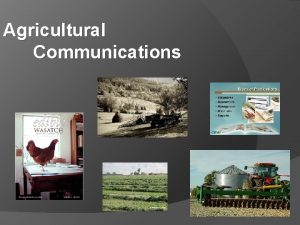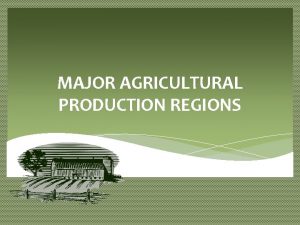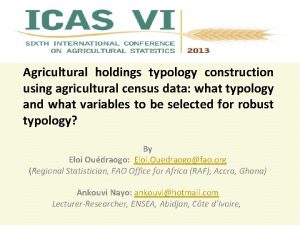Using administrative data to compile agricultural statistics Experiences



















- Slides: 19

Using administrative data to compile agricultural statistics Experiences from the Census of Agriculture 2010 Fiona O’Callaghan, CSO 29 th September 2011

Outline • • Background Available data Analysis/aggregation Merging of data Lessons learnt Future developments Summary

Background ▫ CSO Statement of Strategy includes as a high level goals Minimise response burden, and extend the statistical use of administrative records Improve the scope, quality & timeliness of our statistics Achieve greater efficiencies using best practices ▫ SPAR Report - Statistical Potential of Administrative Records

Background ▫ Up until 2010, CSO conducted 2 annual farm surveys (June & Dec) with sample sizes ranging from 15, 000 to 20, 000 farms. Farm Structure Survey approx 50, 000 farms. June survey: average response burden approx. 30 mins. December survey: average response burden approx. 18 mins. COA 2010: average response burden 26 mins.

Available Data • CSO identified six major data holdings within DAFF which contained relevant information Animal Identification and Movement System (AIM) Single Payment System (SPS) Organic Database REPS database Animal Health Computer System (AHCS) Corporate Client System (CCS)

Available Data ▫ Three of these databases were used for COA 2010 CCS was used in developing the register AIM was used for cattle SPS was used for crops/cereals

Analysis/aggregation ▫ Corporate Client System Contains name, address, DOB, herd number etc. This was merged with the existing CSO Agriculture Register to form a new Register for COA 2010 Issues involving the “unique” identifier, Herd Number, resulting in duplicates Result – 153, 904 Census forms issued

Analysis/aggregation ▫ AIM – involves the use of electronic means to capture data on animal movements through computer links established at livestock markets, meat plants, and export points Data available since 2002 At an aggregate level, the AIM figures for the bovine population have been consistently higher than the CSO estimates for the corresponding date (on average approx. 5% higher) Preliminary comparative analysis performed by CSO in 2008 and 2009 Eliminated 11 cattle questions from Census form

Analysis/aggregation ▫ AIM data consists of the following variables Tag number Herd number DOB Gender Breed Type (Beef/Dairy) Animal Class (Cow, bull, etc. ) Date of calving event

Analysis/aggregation ▫ Need to convert this information into totals for the following categories Breeding Cattle Other Cattle Dairy Cows Other Cows Male: 2 years and over Female: 2 years and over Dairy Heifers* Other Heifers Male: 1 -2 years Female: 1 -2 years Bulls Male: under 1 year Female: under 1 year * Heifers in calf intended for the dairy herd

Analysis/aggregation • Information on heifers-in-calf not available in AIM database, but a proxy can be estimated. • Other categories can be derived directly using gender, DOB, animal class. • Eurostat requires further breakdown of categories into animals for slaughter – currently developing a methodology to model this.

Analysis/aggregation ▫ SPS Information on every eligible parcel of land XY coordinates, Herd Number, Area, Use Preliminary analysis performed in 2009 Eliminated 14 crops/cereals questions from Census form

Analysis/aggregation ▫ SPS XY coordinates used to assign NUTS Region codes at farm level Approx. 45% farms are spread over >1 DED - in these instances the DED containing the largest area owned was assigned

Merging of data ▫ Three separate data files Census returns AIM data SPS data ▫ “Unique” identifier – Herd Number – but many instances where one farmer could be associated with more than one Herd Number

Merging of data ▫ Labour intensive task of matching by name & address Issues with Father & Son with same name & address Different versions of names on different databases – Seamus/James, Sean/John etc. Non-unique addresses ▫ Farms that returned to CSO as Retired/Dead/Not a Farm etc. but active on admin. data

Lessons Learnt • More collaboration between DAFF & CSO • Confidentiality – one-way transfer of information • Parallel pilot run in 2009

Future Developments • Beyond the SPAR Initiative – cross sector efficiencies Piggy-backing on SFP online applications to collect remaining survey items on June Survey • Exploiting geo-coordinates ▫ To produce interactive maps ▫ To link with other databases ▫ Create area frame designs

Summary • Positive development for Farmers & CSO ▫ Reduction in response burden – 25 questions dropped ▫ Reduction in editing & processing of data • Result - a high quality register of agricultural holdings, and high quality data

Questions?
 Linkers
Linkers Compile and go loader
Compile and go loader Compile time polymorphism java
Compile time polymorphism java Nprg051
Nprg051 What is constructor in java
What is constructor in java Compile time polymorphism in c++
Compile time polymorphism in c++ Contoh soal regular expression
Contoh soal regular expression Triples notation adalah
Triples notation adalah Qt arm cross compile
Qt arm cross compile Runtime vs compile time
Runtime vs compile time Cross compile 이란
Cross compile 이란 Compile linux kernel with clang
Compile linux kernel with clang Statistics informed decisions using data 5th edition pdf
Statistics informed decisions using data 5th edition pdf Unit 4 personal safety in agricultural mechanics
Unit 4 personal safety in agricultural mechanics Using job experiences for development assumes that
Using job experiences for development assumes that Introduction to statistics what is statistics
Introduction to statistics what is statistics Administrative data management
Administrative data management Statistics for managers using ms excel solutions
Statistics for managers using ms excel solutions Using system using system.collections.generic
Using system using system.collections.generic Defrost using internal heat is accomplished using
Defrost using internal heat is accomplished using


